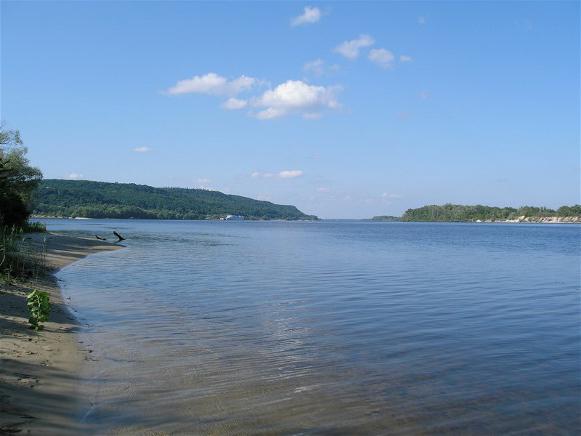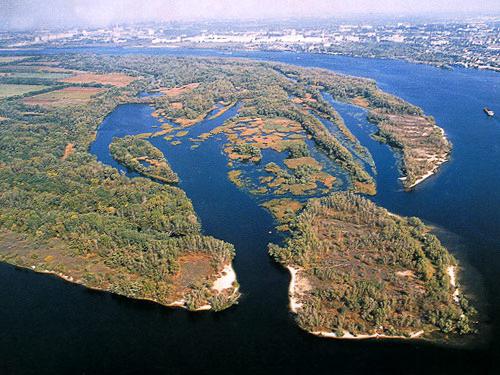Rivers have always played an exceptional role in people's lives. At the dawn of the development of civilization, they served as a source of food and drinking water, protected from enemy attacks. It is not surprising that on the banks of the great waterways, cities, in which history was happening, sprang up like mushrooms after rain.
The main river of the Slavs
This river was known in the ancient world, because the first mention of it dates back to the fifth century. The Greeks called it Borisfen, the Slavs called Slavuta or Slavutich, the Latin name of the river sounds like Danapris. Perhaps from here came the modern name of the main river of the Slavs - the Dnieper, on the banks of which Kiev arose - the mother of Russian cities. There are now the largest cities in the region, and in the past the most important events took place.
The source of the Dnieper, the river of Slavic friendship, is located on the territory of modern Russia. On the border of the Tver and Smolensk regions, about forty kilometers from the Sychevka district center, there is a small Keleck swamp. Here is a commemorative sign that states that it is here that the stream begins, which will turn into a powerful water artery, carrying its waves through solid rock to the Black Sea. And the river itself flows through the territory of Ukraine, Belarus and Russia.
A river begins with a blue brook ...
As we said earlier, the source of the Dnieper is located in Russia. The nearest village of Bocharovo is six kilometers away from it. Previously, the village of Dudkino was considered such, which disappeared from the map in the eighties of the last century. But even in Bocharovo, there were no youth at all, and no more than forty people live in the village itself. Buses practically do not go here - it is economically impractical. But near the place where the source of the Dnieper is located, a church is being built, and at least occasionally, tourists still come. This is not surprising, because the places sacred to all Slavs are very picturesque. Dense forests abound with berries and mushrooms, and in the river itself is full of fish.
Breath of history
So, where are the origins of the Dnieper on the map, we have already found out. Now let's talk about what happened on the banks of an amazing river over the long history of mankind. People lived in these places already in the Stone Age, as evidenced by the numerous finds of archaeologists. Scientists unearthed the ancient settlements only a mile and a half from the Kielce swamp. By the ninth century, the famous and very important path “from the Varangians to the Greeks” had fully developed.

Most of the tracks on the banks of Borisfen left the twentieth century, namely the Second World War. In the fall of 1941, the source of the Dnieper stubbornly defended the 119th Krasnoyarsk Rifle Division. In fierce battles, most of the division's soldiers died, in memory of which later grateful descendants erected a memorial plate and an obelisk. In the village of Aksenino, which today does not exist, another monument was erected - to the civilians who were burned by the Nazis at the turn of 1942-1943. One and a half kilometers from the beginning of the majestic river was a partisan camp. In the area of the source of Slavic pride, many anti-tank ditches, pillboxes, bunkers, as well as mass graves of fallen soldiers were preserved.
Save and save
The source of the Dnieper is today considered a natural monument of regional significance. In the seventies of the twentieth century, pines and Siberian cedars were planted here , a cross and a pointer were erected. Since 2003, in this place it was decided to equip a comprehensive reserve with an area of 32.3 thousand hectares, which includes Lavrovsky and Aksenovsky peat bogs, Gavrilovsky lake of glacial origin. With the blessing of Patriarch Kirill, the Slavic Foundation of Vladimir the Great creates a spiritual and historical-cultural center in these protected areas. The church of the Holy Equal-to-the-Apostles Prince Vladimir the Great, the chapel and the abbot's house have already been erected.
Dnieper River: source and mouth
We wrote a lot about the Dnieper and its source. But one of the largest rivers in Europe has another attraction that is worth mentioning. This is the mouth. Ancient Borisfen flows into the Dnieper estuary of the Black Sea. On the way to it, the river overcomes a serious natural barrier, forming rapids. This problem of navigation was solved only in the twentieth century, having built a cascade of dams. These are the Dnieper Hydroelectric Power Station in Zaporozhye (1927-1932), the Kakhovskaya Hydroelectric Power Station (1950-1956), the Kremenchug (1954-1960), Kiev (1960-1964), Dneprodzerzhinskaya (1956-1964), Kanevskaya Hydroelectric Power Station (1963-1975).

The Dnieper Delta consists of a large number of arms and ducts. In floodplains stretching for hundreds of kilometers, it is better not to walk. At the mouth there are many low and swampy islands of irregular or rounded shape (the so-called saucers). The land here is deserted, since there are practically no forests. But herbs grow in abundance. This is a cattail and sedge, but most of all the reeds, which form real thickets.
But it’s better to see the beauty of the Dnieper at least once, walking along it on a boat, than to read about it hundreds of times and see photos!